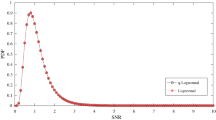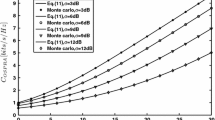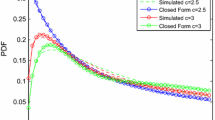Abstract
The characterization of multipath fading and shadowing in wireless communication systems is essential towards the evaluation of various performance measures. It is well known that the statistical characterization of shadowing phenomena is captured by distributions viz., log-normal distribution, gamma distribution and other mixture distributions. However, it is observed that the log-normal distribution fails to characterize the outliers in the fading signal. The extreme fluctuations in the fading signal needs to be characterized efficiently for error free computation of the various performance metrics. In this context, this paper portrays an adaptive generalized Tsallis’ non-extensive q-Lognormal model towards the characterization of various fading channels. This model operates well with the synthesized fading signals and captures the wide range of tail fluctuations to adapt different fading scenarios. The significance and applicability of the proposed novel q-lognormal model in capturing the slow fading channels is validated using different statistical tests viz., chi-square test and symmetric JS measure. Furthermore, essential performance measures viz., the average channel capacity, closed form expression of cumulative distribution function (CDF) in terms of Gauss-Hypergeometric function \({}_2{F_1}\left[ {\mathrm{{a, b, c; z}}} \right] \), moment generating function, higher order moments corresponding to q-Lognormal channel capacity and coefficient of variation is evaluated corresponding to the proposed q-lognormal model performing extensive Monte-Carlo simulation techniques up to \(O(10^7)\).













Similar content being viewed by others
References
Simon, M. K., & Alouini, M. S. (2005). Digital communication over fading channels (Vol. 95). New York: Wiley.
Hansen, F., & Meno, F. I. (1977). Mobile fading rayleigh and lognormal superimposed. IEEE Transactions on Vehicular Technology, 26(4), 332–335.
Coulson, A. J., Williamson, A. G., & Vaughan, R. G. (1988). A statistical basis for lognormal shadowing effects in multipath fading channels. IEEE Transactions on Communications, 46(4), 494–502.
Shankar, P. M. (2017). Fading and shadowing in wireless systems. Berlin: Springer.
Rappaport, T. S. (1996). Wireless communications: principles and practice (Vol. 2). New Jersey: Prentice hall PTR.
Abramowitz, M., Stegun, I. A., & Romer, R. H. (1988). Handbook of mathematical functions with formulas, graphs, and mathematical tables.
Bebortta, S., Singh, A. K., Mohanty, S., & Senapati, D. (2020). Characterization of range for smart home sensors using Tsallis entropy framework. Advanced computing and intelligent engineering (pp. 265–276). Singapore: Springer.
Singh, R., Soni, S. K., Raw, R. S., & Kumar, S. (2017). A new approximate closed-form distribution and performance analysis of a composite Weibull/log-normal fading channel. Wireless Personal Communications, 92(3), 883–900.
Khandelwal, V. (2011). MGF and high order moment of channel capacity in log-normal fading environment. In Proceedings of the 1st International Conference on Wireless Technologies for Humanitarian Relief, 99-106.
Senapati, D. (2016). Generation of cubic power-law for high frequency intra-day returns: Maximum Tsallis entropy framework. Digital Signal Processing, 48, 276–284.
Tsallis, C., & Mechanics, N. E. S. (2004). Construction and Physical Interpretation. Nonextensive Entropy Interdisciplinary Applications, 1–52.
Holtzman, J. M. (1992). A simple, accurate method to calculate spread-spectrum multiple-access error probabilities. IEEE Transactions on Communications, 40(3), 461–464.
Namaki, A., Lai, Z. K., Jafari, G. R., Raei, R., & Tehrani, R. (2013). Comparing emerging and mature markets during times of crises: A non-extensive statistical approach. Physica A: Statistical Mechanics and its Applications, 392(14), 3039–3044.
Li, J., Chen, Q., Long, Z., Wang, W., Zhu, H., & Wang, L. (2021). Spectrum sensing with non-Gaussian noise over multi-path fading channels towards smart cities with IoT. IEEE Access, 9, 11194–11202.
Goldsmith, A. (2005). Wireless communications. Cambridge: Cambridge University Press.
Abe, S., & Bagci, G. B. (2005). Necessity of q-expectation value in nonextensive statistical mechanics. Physical Review E, 71(1), 016139.
Das, S., & Bhattacharya, A. (2020). Application of the mixture of Lognormal distribution to represent the first-order statistics of wireless channels. IEEE Systems Journal, 14(3), 4394–4401.
Shankar, P. M. (2011). Statistical models for fading and shadowed fading channels in wireless systems: A pedagogical perspective. Wireless Personal Communications, 60(2), 191–213.
Polydorou, D. S., & Capsalis, C. N. (1997). A new theoretical model for the prediction of rapid fading variations in an indoor environment. IEEE Transactions on Vehicular Technology, 46(3), 748–754.
Chauhan, P. S., Tiwari, D., & Soni, S. K. (2017). New analytical expressions for the performance metrics of wireless communication system over Weibull/Lognormal composite fading. AEU-International Journal of Electronics and Communications, 82, 397–405.
Shannon, C. E. (2001). A mathematical theory of communication. ACM SIGMOBILE Mobile Computing and Communications Review, 5(1), 3–55.
Lee, W. C. (1990). Estimate of channel capacity in Rayleigh fading environment. IEEE Transactions on Vehicular Technology, 39(3), 187–189.
Laourine, A., Stéphenne, A., & Affes, S. (2007). Estimating the ergodic capacity of log-normal channels. IEEE Communications Letters, 11(7), 568–570.
Bebortta, S., Senapati, D., Rajput, N. K., Singh, A. K., Rathi, V. K., Pandey, H. M., & Tiwari, P. (2020). Evidence of power-law behavior in cognitive IoT applications. Neural Computing and Applications, 32(20), 16043–16055.
Bebortta, S., Singh, A. K., Pati, B., & Senapati, D. (2021). A robust energy optimization and data reduction scheme for IoT based indoor environments using local processing framework. Journal of Network and Systems Management, 29(1), 1–28.
Nayak, G., Singh, A. K., Bhattacharjee, S., & Senapati, D. (2021). A new tight approximation towards the computation of option price. International Journal of Information Technology, 1–9.
Mukherjee, T., Nayak, G., & Senapati, D. (2021). Evaluation of symbol error probability using a new tight Gaussian Q approximation. International Journal of Systems, Control and Communications, 12(1), 60–71.
Panic, S., Stefanovic, M., Vasic, S., Milic, D., & Cvetkovic, A. (2014). On the first and the second order statistics of the capacity of k-\(\mu \) fading channels. Frequenz, 68(9–10), 471–475.
Laourine, A., Stephenne, A., & Affes, S. (2009). On the capacity of log-normal fading channels. IEEE Transactions on Communications, 57(6), 1603–1607.
Sagias, N. C., Zogas, D. A., Karagiannidis, G. K., & Tombras, G. S. (2004). Channel capacity and second-order statistics in Weibull fading. IEEE Communications Letters, 8(6), 377–379.
El Bouanani, F., Ben-Azza, H., & Belkasmi, M. (2012). New results for Shannon capacity over generalized multipath fading channels with MRC diversity. EURASIP Journal on Wireless Communications and Networking, 2012(1), 336.
Mukherjee, T., Singh, A. K., & Senapati, D. (2019). Performance evaluation of wireless communication systems over Weibull/q-Lognormal shadowed fading using Tsallis entropy framework. Wireless Personal Communications, 106(2), 789–803.
Foerster, J. (2002). Channel modelling sub-committee report final. IEEE P802. 15-02/368rs-SG3a.
Alouini, M. S., & Goldsmith, A. J. (1999). Area spectral efficiency of cellular mobile radio systems. IEEE Transactions on Vehicular Technology, 48(4), 1047–1066.
Nayak, G., Singh, A. K., & Senapati, D. (2020). Computational modeling of Non-Gaussian option price using non-extensive Tsallis entropy framework. Computational Economics, 1–19.
Mukherjee, T., Pati, B., & Senapati, D. (2019). Performance Evaluation of Composite Fading Channels Using q-Weibull Distribution. Progress in Advanced Computing and Intelligent Engineering (pp. 317–324). Singapore: Springer.
Singh, A. K., Senapati, D., Mukherjee, T., & Rajput, N. K. (2019). Adaptive Applications of Maximum Entropy Principle. Progress in Advanced Computing and Intelligent Engineering (pp. 373–379). Singapore: Springer.
Acknowledgements
The authors would like to thank the Department of Science and Technology (DST), for their continuous support during the period of this research. The authors are also appreciative to the reviewers for their insightful comments that helped to improve the manuscript’s overall quality and presentation.
Author information
Authors and Affiliations
Additional information
Publisher's Note
Springer Nature remains neutral with regard to jurisdictional claims in published maps and institutional affiliations.
Appendices
Appendix
Proof of (Eq. 10)
The CDF of the proposed q-Lognormal distribution can be expressed as
where \(\xi \) is the normalized constant as defined in Eq. 8. Replacing \(ln(t)=x\), we obtain
Now, substituting \(\frac{{x - \mu }}{\sigma } = y\) we obtain
Finally, after some mathematical computations, the CDF corresponding to the q-Lognormal distribution can be expressed in terms of Gauss Hypergeometric function [6] as
Proof of (Eq. 25)
From Eq. 23, it is obtained
Applying the transformation \(\mathop {\lim }\limits _{q \rightarrow 1}\) in Eq. 16 and substituting \(ln(\gamma )=y\), the MGF is obtained as
On further simplification, we get
Now, w.r.t \(y>0\), \(\exp (-y)<1\), it is obtained
where \({{{(z)}_v}}\) is the lower factorial and is represented as \({(z)_v} = z(z - 1)(z - 2)...(z - v + 1)\) [9] .
Equation 53 along with Eq. 54 yields
Considering \(\frac{1}{{\sigma \sqrt{2\pi } }}\int \limits _0^\infty {\exp \left( { - yv} \right) } \exp \left( { - \frac{{{{\left( {y + \mu } \right) }^2}}}{{2{\sigma ^2}}}} \right) dy = \sigma \sqrt{\frac{\pi }{2}} \mathrm {erfcx}\left( {\frac{{v\sigma }}{{\sqrt{2} }} + \frac{\mu }{{\sqrt{2} \sigma }}} \right) \exp \left( { - \frac{{{\mu ^2}}}{{2{\sigma ^2}}}} \right) \) and \(\mathrm {erfcx}(t) = \exp ({t^2})\mathrm {erfc}(t)\), the MGF corresponding to the q-Lognormal channel capacity, \(q\rightarrow 1\) is evaluated and is expressed in Eqs. 24 and 25.
Rights and permissions
About this article
Cite this article
Mukherjee, T., Senapati, D. An adaptive q-Lognormal model towards the computation of average channel capacity in slow fading channels. Telecommun Syst 79, 341–355 (2022). https://doi.org/10.1007/s11235-021-00843-5
Accepted:
Published:
Issue Date:
DOI: https://doi.org/10.1007/s11235-021-00843-5




